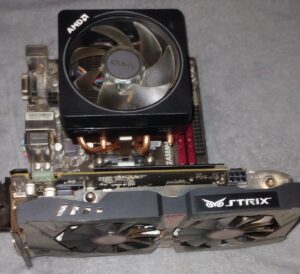
Building a custom desktop PC is a great way to get a reliable, repairable and upgradable machine tailored to your needs. A lot of the standard name brand machines in stores are made with proprietary parts with limited options making upgrades and repairs more expensive and much harder to deal with down the line. Getting a custom built system means you can select from standardized parts which can be replaced relatively easily and you have the freedom to upgrade things down the line.
Basic list to think about for building a new PC
- Budget range
- Main use of the system (basic business, photo or video editing, gaming, general home use etc.) For basic business systems graphics may not be required, for general use i recommend a low end graphics card or a higher end AMD processor with built in graphics
- Are there space limitations for the computer? Also think about the location it will be used IE: under desk, on desk, in workshop, carpet or hard flooring if it will be floor standing. if it will be placed on a carpet floor you can look at a case with larger feet to help with airflow. if you need a system in a dirty workshop area then maybe you want something that is low power and can have more passive cooling options instead of fans
- External connectors. if you have a lot of devices to plugin you might want a board with more ports available or plan on getting an external USB hub if you need a small form factor build.
- Storage space needs. If you edit videos or play a lot of games you will need a much bigger drive than if you only need to check email and surf the web. (more on storage at the end of the page)
- Graphics cards. If you only need email and web surfing and watching videos then you may not need a dedicated graphics card and anything with onboard graphics will work for you.
- This next one will be a rare option but still valid for some small businesses and hobbyist shops.
Do you need to install any extra hardware for devices (ie: expansion cards for special cords on some sewing machines, automotive scanners or other workshop equipment floppy drives, cd drives etc.) This can affect both the main board and the case choice, as a smaller board will have less available ports to add cards, and most newer cases do not have any space for a cd drive or floppy disk, yes i know they are very obsolete and people dont even know what they are anymore! HA! but some old manufacturing machines are still in use in smaller businesses or have been bought second hand by hobbyists and they have floppy drives or different cable port needs
Basic build specification options
For basic business and home use systems you will want a quad core processor or better, minimum 8GB ram and 512gb solid state drive with an extra drive for storage or backup if needed. Add in a previous generation low end graphics card like an nvidia 1660ti , 2060 or 3050($150-250 graphics only) if you play some less demanding games from time to time. Or a mid range AMD Ryzen processor with built in graphics may also be an option for this very light gaming use scenario, for this option i would also bump up to 16gb of ram because the built in graphics shares that memory.
For light to moderate gaming: 6 core processor or better 16GB ram and 1TB solid state drive and a low to mid range graphics card -nvidia rtx 3060/4070 or radeon 5700xt /6700xt($250-550 graphics only) ***the intel arc a750 or a770 are also in the bottom this range but as intel is new to the graphics market there are still some major performance issues to be fixed in games– especially in older titles which is why the arc a580 is also not in my list for the general home use systems either.
For heavy gaming or streaming: 8 core processor or better 32GB ram and 2TB solid state drive plus extra storage drives depending on your needs and a mid to high end graphics card -nvidia 4070ts or better or radeon 7900xtx ($830-1200+graphics only)
For lots of photo editing (and occasional video editing) 6 core processor or better, and 16gb ram, with nvidia 3070 or radeon 6700xt are good options.
For more frequent video editing 8+ core processor, 32-64gb ram and nvidia 4070 or radeon 7800xt or better will be much faster than the previous option.
A few guidelines for picking storage needs.
A full storage drive get much slower, so when you pick your drives plan ahead and figure that the size is actually only 80% of the listed capacity. OS and essential programs will normally use around 150-250gb. videos- 1 hour 1080p =1.4gb, 1hour 4k=25gb. And recently release games can be anywhere from 50-150gb each and they are only getting bigger. For a business system i would also recommend having an external drive and making a full backup copy regularly and unplugging the drive so if there are any power related issues that information will be safe.
